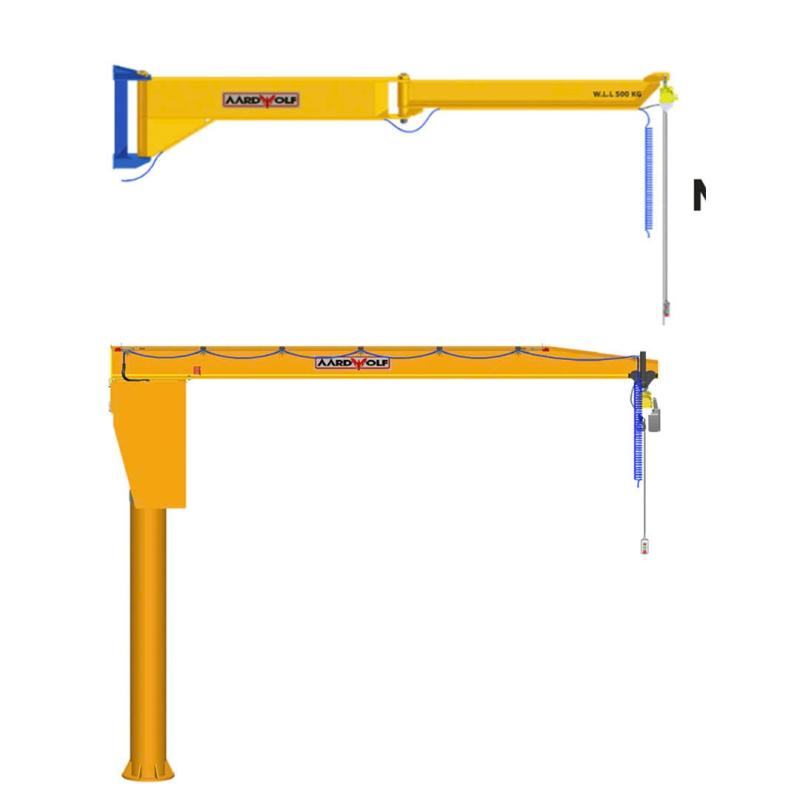



However, understanding the variety of jib crane types—and when an alternative might be more suitable—is crucial to maximizing efficiency and minimizing downtime.
In this guide, we explore the most common types of jib cranes, their features, benefits, and when it makes sense to choose an alternative like gantry cranes, davit arms, or monorail systems. If you're evaluating your material handling options, this comprehensive breakdown will help you choose the right lifting tool for the job.
Jib cranes are overhead lifting systems characterized by a horizontal arm (jib or boom) that supports a hoist mechanism. This arm is typically mounted to a vertical support or a wall, allowing the crane to rotate and move materials within a set radius.
Designed for repetitive lifting in localized areas, jib cranes are commonly used in manufacturing, warehousing, logistics, automotive repair, and maintenance operations. Their simplicity, adaptability, and scalability make them a go-to option for efficient material handling.
For a deep dive into different designs and structural innovations, explore Jib Cranes Installation.
The freestanding jib crane is perhaps the most versatile. Mounted on a reinforced concrete base, it offers a full 360° rotation and is capable of handling heavier loads than most alternatives.
Best for: Loading docks, fabrication shops, outdoor yards
Advantages: High load capacity, complete rotation, independent installation
A wall mounted jib crane is attached to a structural wall or column and provides 180° to 200° rotation. It saves valuable floor space and is ideal for indoor use.
Best for: Assembly lines, workstations, confined production areas
Advantages: Space-saving, easy to integrate into existing infrastructure
Explore models:
Ceiling mounted jib cranes are suspended from overhead building structures. They offer extensive coverage without taking up floor or wall space.
Best for: Cleanrooms, packaging stations, high-density environments
Advantages: Excellent reach, no floor obstruction
The articulating jib crane features two pivot arms, allowing for complex, multi-directional movements around obstacles, machines, or tight corners.
Best for: CNC machines, tool stations, areas with irregular layouts
Advantages: Flexible motion, high precision, tight-space capability
Also known as a pillar-mounted jib crane, this model combines the features of freestanding and wall-mounted types but offers enhanced durability and 360° movement.
Best for: Heavy-duty industrial applications, shipping yards, assembly plants
Advantages: Strong vertical support, high load tolerance
While jib cranes are incredibly effective, they may not always be the best fit. Factors like travel distance, load movement path, and installation space could point to alternative solutions.
| Use Case | Consider Jib Crane? | Alternative Option |
|---|---|---|
| Repetitive lifting at one station | ✅ Ideal | – |
| Moving heavy loads over long distances | ❌ Limited span | Gantry crane |
| Portable lifting across multiple locations | ❌ Fixed installation | Davit arm or mobile gantry |
| Irregularly shaped work zones | ⚠️ Articulating only | Custom crane system |
Learn more about the key differences in this Aardwolf Jib Cranes Comparison.
Modular design: Easily integrated with hoists, clamps, or vacuum lifters
Customizable rotation: 180° to 360°, depending on mounting type
Efficient material flow: Especially when used in cells or assembly lines
Lower maintenance costs: Fewer moving parts compared to bridge cranes
Want to increase ROI? Here’s how to Enhance Efficiency with a Jib Crane.
Determine how frequently you’ll lift and how much each load weighs. Heavier, continuous-duty operations will require reinforced masts and industrial-grade hoists.
Depending on whether you have floor space, wall access, or ceiling structure availability, the right model may vary between freestanding, wall-mounted, or ceiling-mounted.
Larger booms offer wider coverage but require more space. Choose 180°, 200°, or 360° rotation based on your operational footprint.
Jib cranes can work in tandem with other material handling systems, including overhead rails and gantry cranes. Make sure your choice complements your full equipment layout.
The future of jib cranes is being shaped by automation, digital integration, and smarter safety features.
Trends to watch:
Wireless control and smart diagnostics
Collision detection and safety alerts
Integration with conveyor and robotic systems
Lightweight, composite boom materials
Stay ahead with the Future Trends of Jib Cranes.
A crane is only as good as its setup. Work with trained professionals to ensure correct installation, especially for freestanding and pillar types that require concrete foundations.
Routine maintenance includes:
Lubricating swivel joints and bearings
Inspecting wire ropes or chains
Checking for structural fatigue or corrosion
Testing emergency stop systems
Consult with your vendor on service intervals and load testing schedules to ensure safety and compliance.
Jib cranes offer unparalleled value in localized material lifting, especially when space, safety, and repeatability are priorities. But alternatives such as gantry cranes and davit arms have their place—particularly when extended movement or portability is key.
Whether you're upgrading your facility or planning a new installation, your choice should reflect your lifting goals, structural limitations, and workflow demands.
A smart decision today ensures a safer, faster, and more productive tomorrow.
References
1. How to operate a Jib Cranes safely
3. Over brace jib crane wall mounted
5. Is a Jib Crane a Gantry Crane
6. Articulated Jib Crane Wall Mounted
8. Manual Counterbalance Crane
10. Over Braced Jib Crane Column Mounted
Sign up to receive the latest info on new Aardwolf products, special offers and more.
By signing up you agree to receive emails from Aardwolf with news, special offers, promotions and other information. You can unsubscribe at any time.